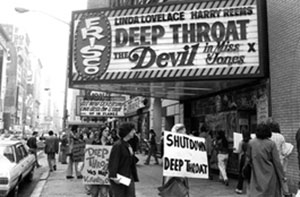By Eli Ungar
If you’ve ever seen the 1972 porn classic Deep Throat, it’s hard to understand exactly what all of the fuss is about. After all, it’s a low budget, badly acted film with the absurd premise that its main character Linda Lovelace, who plays herself, has a clitoris located at the bottom of her throat. This absurdity is compounded by the fact that we see Ms. Lovelace’s actual clitoris, or “tinkler” as the film likes to euphamize, a number of times throughout the course of the film in its anatomically correct position. How could such a silly film go on to become the most profitable movies due to low production costs in the history of cinema? A new documentary called Inside Deep Throat written and directed by team Fenton Bailey and Randy Barbato (of Party Monster fame) and produced by Brian Grazer, seeks to explain the Deep Throat phenomenon.
The film starts with a shot of the writer-director of Deep Throat, Gerard Damiano, now in his seventies, picking up his mail and greeting his suburban neighbours. As we get to know him a little better, we learn that Damiano is a likable character who was a hairdresser before he got into porn production. The film reports that in the early ’70s, before the advent of video, filmmakers who made hardcore pornography saw themselves as independent artists. Indeed, as Wes Craven confesses, he along with many other mainstream Hollywood directors got their start in hardcore porn.
Early on, the documentary sets up the central conflict between the producers of Deep Throat and the people in the Nixon administration who sought to have the film banned. Enter the celebrated talking heads of Alan Dershowitz, Larry Flynt, Hugh Heffner, Camille Paglia, and Dr. Ruth Westheimer, to name but a few, who serve as the “voices of reason” in the film. These celebrities are pitted against a handful of the people who were responsible for prosecution of the film, who stand by their original positions on Deep Throat even after all these years. As the story progresses, we learn that the person who was made a scapegoat for Deep Throat was Harry Reems, the actor who played the quirky doctor character that prescribes deep throat fellatio to Linda Lovelace as a solution to her frigidity. Though he was only paid $250 for his performance, Reems was put on trial and faced up to five years in prison for his participation. We learn that though he was eventually let ods of mob film distribution are brought into focus.
Stylistically, Inside Deep Throat is fast-paced, using every trick in the editor’s arsenal. The source material comes from all over and includes copious amounts of stock footage and some animated clips. But this is where I have some problems with Bailey and Barbato’s approach. I understand that they are trying to argue that the forces of repression and the threats to the first amendment that existed when Deep Throat was released are once again rearing their ugly head in our post-wardrobe-malfunction neo-Con era. However, the stylistic cheap-shots taken at the ex-Nixon people do the film’s credibility a great disservice. For example, on a number of occasions, the filmmakers take advantage of the after-interview footage of these individuals to make them look foolish. Furthermore, much of the stock footage is used in a spirit of irony, which has the dubious effect of a pat on the back to the “savvy” viewer. This type of “look-how-silly-they-were” filmmaking has no place in the treatment of such serious issues.
Perhaps the most interesting part of the Deep Throat story is that of Lovelace herself. Born as Linda Boreman, she was married to an abusive husband, Chuck Traynor, who realized that his wife had a remarkable talent for fellatio and made the contact that got her into the film. Throughout the production and distribution of Deep Throat , Boreman, now Lovelace, seemed to support the film wholeheartedly. However, as feminists turned against pornography in the mid-to-late ’70s, they swept Lovelace up in their wake. Lovelace was so taken by the feminists’ arguments that she became their poster child and testified against the film. She claimed that she had been forced to make it and that watching it amounted to watching her being raped. As Deep Throat continued to rake in money for the mob, none of the participants in its production, including Lovelace herself, saw any money from its profits. Desperate and destitute, Lovelace turned away from the feminists and posed nude for money at the age of 51. In 2002, Lovelace died in a car crash. Though we do learn about Lovelace’s story, it ends up playing a rather peripheral role in the film. There is very little interview footage of Lovelace and the short clip presented is only introduced in the last 10 minutes.
Bailey and Barbato must be commended for keeping the hardcore images from the original film in their retrospective. After all, this move garnered their documentary the box-office killing NC-17 rating. Despite this and although the film is both informative and entertaining, Inside Deep Throat ultimately fails to transcend its political agenda, giving it an oversimplified feeling and leaving us as viewers wanting a treatment that’s a little more…Adult
March 2005








